Related Research Articles

Metastasis is a pathogenic agent's spreading from an initial or primary site to a different or secondary site within the host's body; the term is typically used when referring to metastasis by a cancerous tumor. The newly pathological sites, then, are metastases (mets). It is generally distinguished from cancer invasion, which is the direct extension and penetration by cancer cells into neighboring tissues.
Inflammatory breast cancer (IBC) is one of the most aggressive types of breast cancer. It can occur in women of any age. It is referred to as "inflammatory" due to its frequent presentation with symptoms resembling a skin inflammation, such as erysipelas.

Hepatocyte growth factor receptor is a protein that in humans is encoded by the MET gene. The protein possesses tyrosine kinase activity. The primary single chain precursor protein is post-translationally cleaved to produce the alpha and beta subunits, which are disulfide linked to form the mature receptor.
The epithelial–mesenchymal transition (EMT) is a process by which epithelial cells lose their cell polarity and cell–cell adhesion, and gain migratory and invasive properties to become mesenchymal stem cells; these are multipotent stromal cells that can differentiate into a variety of cell types. EMT is essential for numerous developmental processes including mesoderm formation and neural tube formation. EMT has also been shown to occur in wound healing, in organ fibrosis and in the initiation of metastasis in cancer progression.
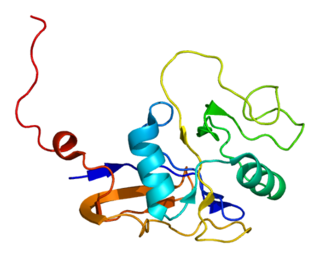
The CD44 antigen is a cell-surface glycoprotein involved in cell–cell interactions, cell adhesion and migration. In humans, the CD44 antigen is encoded by the CD44 gene on chromosome 11. CD44 has been referred to as HCAM, Pgp-1, Hermes antigen, lymphocyte homing receptor, ECM-III, and HUTCH-1.

E-selectin, also known as CD62 antigen-like family member E (CD62E), endothelial-leukocyte adhesion molecule 1 (ELAM-1), or leukocyte-endothelial cell adhesion molecule 2 (LECAM2), is a selectin cell adhesion molecule expressed only on endothelial cells activated by cytokines. Like other selectins, it plays an important part in inflammation. In humans, E-selectin is encoded by the SELE gene.
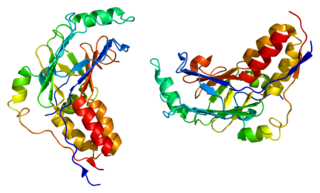
Mothers against decapentaplegic homolog 3 also known as SMAD family member 3 or SMAD3 is a protein that in humans is encoded by the SMAD3 gene.
Triple-negative breast cancer (TNBC) is any breast cancer that either lacks or shows low levels of estrogen receptor (ER), progesterone receptor (PR) and human epidermal growth factor receptor 2 (HER2) overexpression and/or gene amplification. Triple-negative is sometimes used as a surrogate term for basal-like.

Leukotriene B4 receptor 2, also known as BLT2, BLT2 receptor, and BLTR2, is an Integral membrane protein that is encoded by the LTB4R2 gene in humans and the Ltbr2 gene in mice.
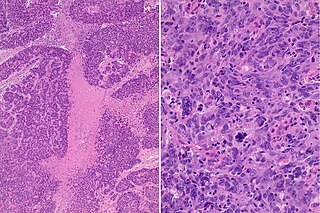
The basal-like carcinoma is a recently proposed subtype of breast cancer defined by its gene expression and protein expression profile.
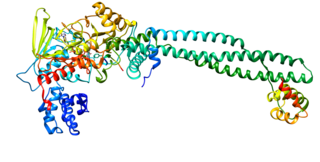
Zinc finger protein SNAI1 is a protein that in humans is encoded by the SNAI1 gene. Snail is a family of transcription factors that promote the repression of the adhesion molecule E-cadherin to regulate epithelial to mesenchymal transition (EMT) during embryonic development.

MCF-7 is a breast cancer cell line isolated in 1970 from a 69-year-old White woman. MCF-7 is the acronym of Michigan Cancer Foundation-7, referring to the institute in Detroit where the cell line was established in 1973 by Herbert Soule and co-workers. The Michigan Cancer Foundation is now known as the Barbara Ann Karmanos Cancer Institute.
Breast cancer classification divides breast cancer into categories according to different schemes criteria and serving a different purpose. The major categories are the histopathological type, the grade of the tumor, the stage of the tumor, and the expression of proteins and genes. As knowledge of cancer cell biology develops these classifications are updated.
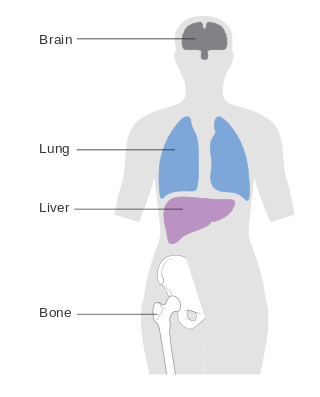
Metastatic breast cancer, also referred to as metastases, advanced breast cancer, secondary tumors, secondaries or stage IV breast cancer, is a stage of breast cancer where the breast cancer cells have spread to distant sites beyond the axillary lymph nodes. There is no cure for metastatic breast cancer; there is no stage after IV.
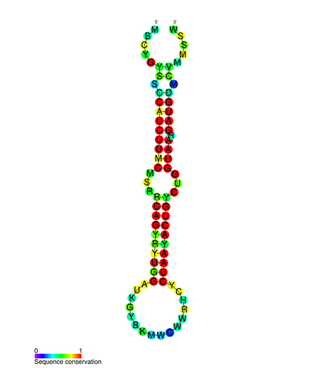
In molecular biology, the miR-200 microRNA is a short RNA molecule. MicroRNAs function to regulate the expression levels of other genes by binding and cleaving mRNAs or inhibiting translation. The miR-200 family contains miR-200a, miR-200b, miR-200c, miR-141, and miR-429. There is growing evidence to suggest that miR-200 microRNAs are involved in cancer metastasis.
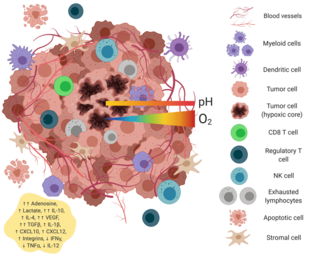
The tumor microenvironment is a complex ecosystem surrounding a tumor, composed of cancer cells, stromal tissue and the extracellular matrix. Mutual interaction between cancer cells and the different components of the tumor microenvironment support its growth and invasion in healthy tissues which correlates with tumor resistance to current treatments and poor prognosis. The tumor microenvironment is in constant change because of the tumor's ability to influence the microenvironment by releasing extracellular signals, promoting tumor angiogenesis and inducing peripheral immune tolerance, while the immune cells in the microenvironment can affect the growth and evolution of cancerous cells.
MDA-MB-468 is a cell line that was isolated from a 51-year-old female human in 1977, and is commonly used in breast cancer research. MDA-MB-468 cells were extracted from a pleural effusion of mammary gland and breast tissues, and have proven useful for the study of metastasis, migration, and breast cancer proliferation.

4T1 is a breast cancer cell line derived from the mammary gland tissue of a mouse BALB/c strain. 4T1 cells are epithelial and are resistant to 6-thioguanine. In preclinical research, 4T1 cells have been used to study breast cancer metastasis as they can metastasize to the lung, liver, lymph nodes, brain and bone. The cells are known to be highly aggressive in live tissues.

Relda Marie Cailleau was an American scientist primarily known for her establishment of a series of breast cancer cell lines that have been crucial to the discovery of anticancer drugs and to an understanding of breast cancer biology.

Ironomycin is a derivative of salinomycin and potent small molecule against persister cancer stem cells, that is under preclinical evaluation by SideROS for the treatment of cancer. Ironomycin was shown to induce ferroptosis in breast cancer cell lines and its mechanism of action involves the targeting of lysosomal iron.
References
- ↑ Cailleau R, Young R, Olivé M, Reeves WJ (September 1974). "Breast tumor cell lines from pleural effusions". Journal of the National Cancer Institute. 53 (3): 661–674. doi:10.1093/jnci/53.3.661. PMC 7364228 . PMID 4412247.
- 1 2 "Cellosaurus MDA-MB-231 (CVCL_0062)". Cellosaurus. January 30, 2024.
- ↑ Liu H, Zang C, Fenner MH, Possinger K, Elstner E (May 2003). "PPARgamma ligands and ATRA inhibit the invasion of human breast cancer cells in vitro". Breast Cancer Research and Treatment. 79 (1): 63–74. doi:10.1023/a:1023366117157. PMID 12779083. S2CID 25517953.
- ↑ Chavez KJ, Garimella SV, Lipkowitz S (2010). "Triple negative breast cancer cell lines: one tool in the search for better treatment of triple negative breast cancer". Breast Disease. 32 (1–2): 35–48. doi:10.3233/BD-2010-0307. PMC 3532890 . PMID 21778573.
- ↑ Holliday DL, Speirs V (August 2011). "Choosing the right cell line for breast cancer research". Breast Cancer Research. 13 (4): 215. doi: 10.1186/bcr2889 . PMC 3236329 . PMID 21884641.
- ↑ Prat A, Parker JS, Karginova O, Fan C, Livasy C, Herschkowitz JI, et al. (2010). "Phenotypic and molecular characterization of the claudin-low intrinsic subtype of breast cancer". Breast Cancer Research. 12 (5): R68. doi: 10.1186/bcr2635 . PMC 3096954 . PMID 20813035.
- ↑ Gowrikumar S, Singh AB, Dhawan P (December 2019). "Role of Claudin Proteins in Regulating Cancer Stem Cells and Chemoresistance-Potential Implication in Disease Prognosis and Therapy". International Journal of Molecular Sciences. 21 (1): 53. doi: 10.3390/ijms21010053 . PMC 6982342 . PMID 31861759.
- ↑ Hollestelle A, Nagel JH, Smid M, Lam S, Elstrodt F, Wasielewski M, et al. (May 2010). "Distinct gene mutation profiles among luminal-type and basal-type breast cancer cell lines" (PDF). Breast Cancer Research and Treatment. 121 (1): 53–64. doi:10.1007/s10549-009-0460-8. PMID 19593635. S2CID 22587331.
- ↑ Kim RK, Suh Y, Yoo KC, Cui YH, Kim H, Kim MJ, et al. (January 2015). "Activation of KRAS promotes the mesenchymal features of basal-type breast cancer". Experimental & Molecular Medicine. 47 (1): e137. doi:10.1038/emm.2014.99. PMC 4314588 . PMID 25633745.
- ↑ Huang Z, Yu P, Tang J (2020-06-11). "Characterization of Triple-Negative Breast Cancer MDA-MB-231 Cell Spheroid Model". OncoTargets and Therapy. 13: 5395–5405. doi: 10.2147/OTT.S249756 . PMC 7295545 . PMID 32606757.
- ↑ Mohammed F, Rashid-Doubell F, Taha S, Cassidy S, Fredericks S (August 2020). "Effects of curcumin complexes on MDA‑MB‑231 breast cancer cell proliferation". International Journal of Oncology. 57 (2): 445–455. doi:10.3892/ijo.2020.5065. PMC 7307592 . PMID 32626932.
- ↑ Raut J, Sarkar O, Das T, Mandal SM, Chattopadhyay A, Sahoo P (December 2023). "Efficient delivery of methotrexate to MDA-MB-231 breast cancer cells by a pH-responsive ZnO nanocarrier". Scientific Reports. 13 (1): 21899. Bibcode:2023NatSR..1321899R. doi:10.1038/s41598-023-49464-9. PMC 10713526 . PMID 38081993.
- ↑ Liu S, Dong Y, Wang Y, Hu P, Wang J, Wang RY (December 2021). "Pristimerin exerts antitumor activity against MDA-MB-231 triple-negative breast cancer cells by reversing of epithelial-mesenchymal transition via downregulation of integrin β3". Biomedical Journal. 44 (6 Suppl 1): S84 –S92. doi:10.1016/j.bj.2020.07.004. PMC 9038948 . PMID 35652598.
- ↑ Govindaraj S, Ganesan K, Dharmasivam M, Raman L, Alam MM, Amanullah M (October 2023). "Synthesis of potent MDA-MB 231 breast cancer drug molecules from single step". Scientific Reports. 13 (1): 18241. Bibcode:2023NatSR..1318241G. doi:10.1038/s41598-023-45455-y. PMC 10600176 . PMID 37880270.
- ↑ Wright LE, Ottewell PD, Rucci N, Peyruchaud O, Pagnotti GM, Chiechi A, et al. (2016). "Murine models of breast cancer bone metastasis". BoneKEy Reports. 5: 804. doi:10.1038/bonekey.2016.31. PMC 5108088 . PMID 27867497.
- 1 2 Jekabsons MB, Merrell M, Skubiz AG, Thornton N, Milasta S, Green D, et al. (February 2023). "Breast cancer cells that preferentially metastasize to lung or bone are more glycolytic, synthesize serine at greater rates, and consume less ATP and NADPH than parent MDA-MB-231 cells". Cancer & Metabolism. 11 (1): 4. doi: 10.1186/s40170-023-00303-5 . PMC 9940388 . PMID 36805760.
- ↑ Minn AJ, Gupta GP, Siegel PM, Bos PD, Shu W, Giri DD, et al. (July 2005). "Genes that mediate breast cancer metastasis to lung". Nature. 436 (7050): 518–524. Bibcode:2005Natur.436..518M. doi:10.1038/nature03799. PMC 1283098 . PMID 16049480.